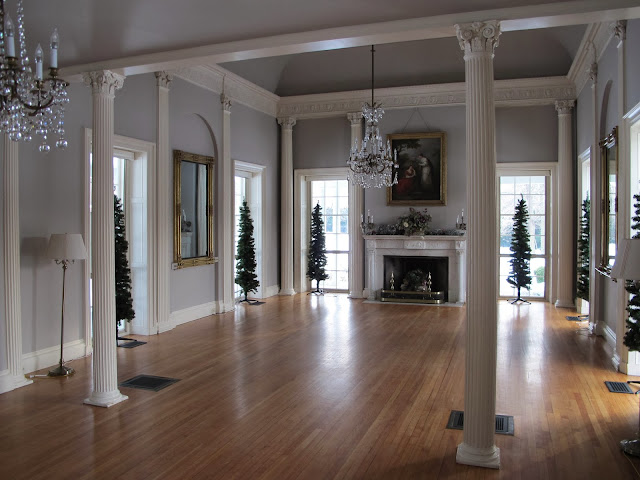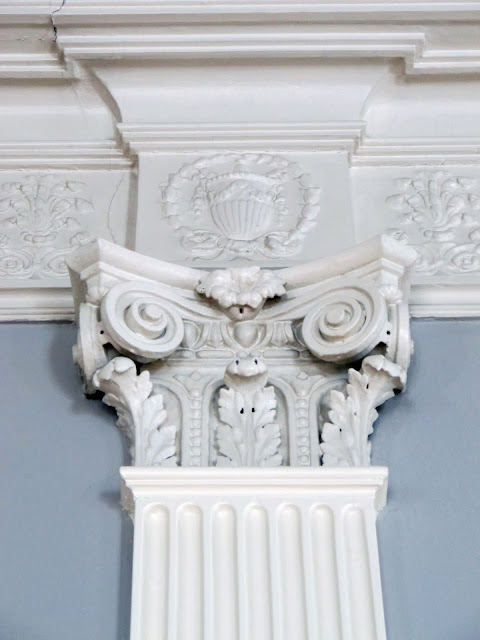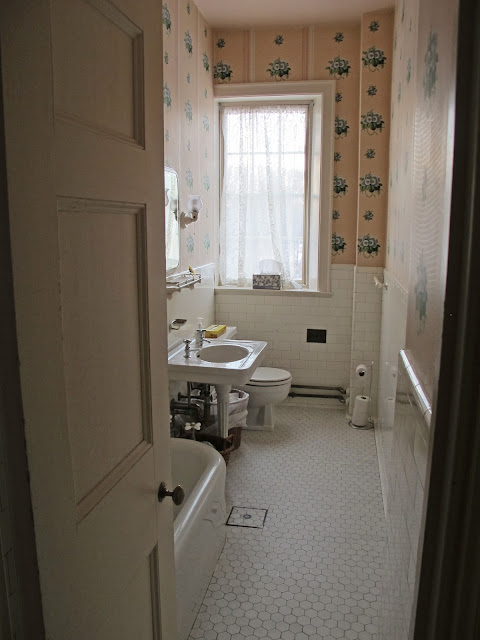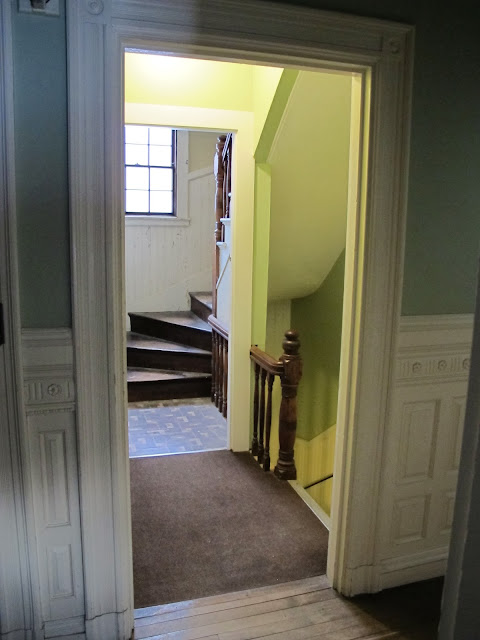I've just finished reading "Former People; The Final Days of the Russian Aristocracy" by Douglas Smith, a sobering tale if ever there was. In our country, Fox News and MSNBC may detest one another but neither thinks seriously of liquidating the other. Our new mayor, Mr. deBlasio is not going to arrest his predecessor, Mr. Bloomberg. Secret police officers do not stage 2 AM raids on homophobic duck hunters. Furious peasants do not loot and burn manor houses in better zip codes. Cleveland Amory notwithstanding, the American upper class has had a lot gentler treatment than their Russian analogs. A case in point is Boston's Lyman family, whose ancestral country estate in Waltham I'm visiting today.
The elevation below shows the central pavilion of the Vale, as it was called, designed by Samuel McIntire (1757-1811) and completed in 1798 for Theodore Lyman (1753-1839), a cultured Boston merchant grown rich from the China trade. McIntire is a legend in New England, famous for elegantly symmetrical Federal houses designed for his era's "one percent." There's even a Samuel McIntire Historic District in Salem, Mass.
Here's McIntire's Vale - before Queen Victoria. The style is usually described as Federal, but I think the classically ornamented central block with outrigger pavilions connected by hyphens is more accurately described as Palladian. It was not a very big house, but certainly a beautiful one. Construction started in 1793, the year the Jacobins unleashed the Reign of Terror. The eastern pavilion, seen to the right in the image below, still contains an exquisite 18th century ballroom. When Lyman's eldest son George W. (1786-1880) inherited the place in 1839, he expanded its famous greenhouses and built a trio of Mansarded Victorian summer places for his 3 married daughters on a portion of the estate. ('Grave, but Interesting,' a 'Big Old Houses' post from last month, tells one of their stories).
By the time George Lyman's eldest son, Arthur T. (1832-1915) inherited in 1880, his grandfather's country house was an unfashionable antique, both style-wise and mechanically. Plus which, it was inconveniently cramped for a family of eight, not counting servants. Years earlier, the Lyman men forsook the China trade to become textile magnates. Hiring architect Henry W. Hartwell (1833-1919), a high Victorian with a devoted following among what I suppose you'd call "fat cat" capitalists, seems, to me anyway, a natural choice for a Victorian industrialist like Lyman. Hartwell added new kitchen, laundry and servant facilities on the west, raised the second floor above the hyphens and pavilions in order to accommodate additional bedrooms (he left the ballroom untouched), goosed the central block upwards with an entirely new third floor full of servants' rooms, and tacked a pair of exceedingly un-Palladian two-story box bays onto the main blocks' south facade. The result was imposing, if no longer quite as beautiful.
The next owner was Lyman's son Arthur Jr. (1861-1933), whose marriage to Susan Cabot, per The New York Times of October 5, 1888, "brought together an unusually large number of representatives of old New England stock. The eight bridesmaids represented the families of Cabot, Mason, Coolidge, Codman, Lowell, Lyman and Courtis, and the ushers were of equally distinguished lineage." To many observers, including, I'm afraid, most real estate brokers, Hartwell's exteriors looked "colonial." However, heavy Victoriana raged within. In 1917, Arthur Jr. hired a smart Boston decorator and dealer named Nonie Tupper, of whom I cannot find any record, to do the place over in the newly fashionable colonial revival style. I doubt she tore off the balustrades or junked the shutters, all of which are missing in the modern view below, but with the exception of the main stair, the paneled library and bit of dado here and there, pretty much everything else inside was ripped out and replaced with restrained millwork and period repro mantelpieces - except the ballroom, which escaped alteration once again.
Let's make a counter-clockwise circuit of the building before going inside. The blank windows on the second floor of the east pavilion screen the upper portion of the double height ballroom. The porch wraps around to the rear of the house, where it overlooks a lawn bounded on the north by greenhouses. This huge range of vintage glazed buildings has been in nonstop operation since 1796. Repeatedly enlarged during two plus centuries, they are the oldest operating greenhouses in the United States.
In addition to the ballroom, an oval salon on the main floor also survives from the original McIntire design. A two-story bow on the house's north wall, the upper part of which is visible in the image below, articulates the line of the salon's north wall, plus that of a bedroom above it.
The kitchen courtyard is located at the western end of the house. A section of the Hartwell additions borders it on the left in the image below.
Time to go inside.
Once across the threshold, the coup d'oeil, given the scale of the exterior, is one of unexpected primness. The plan is McIntire's - reception, dining and salon arranged around a T-shaped central hall. The entrance to the oval salon is straight ahead, on axis with the front door. To the left of the salon, the hall leads west to the main stair; to the right, it leads east to the ballroom. We'll glance at the stair, come back to the salon, and head to the ballroom.
Just short of the ballroom is a peculiar open-sided "mud room." An exterior door, barely visible on the right, opens onto the north-facing porch. Nonie Tupper's ruthless imposition of "good taste," ca. 1917, has banished not just the the Victorian wicker and rosewood, but the cornice molding, mantelpiece, paneled doors, door surrounds and the dado. The fireplace hearth and the heat register are about all that's left, either from the Hartwell or the McIntire eras.
The doorway to the ballroom speaks eloquently, in scale and detail, to the early 20th century vogue for the colonial - even though the doors were clearly re-purposed from the Victorian mud room. The ballroom beyond, however, is pure 18th century. As for those distracting fake Xmas trees, "Bah humbug!" I say.
The interesting vintage views below, courtesy of Historic New England, show the ballroom as Ms. Tupper decorated it in 1917 and, below that, as it looked during the Victorian period. Except for the furniture and the dreadful Victorian overmantel, this room, even including its chandeliers, has survived unchanged for over two centuries.
Let's exit the ballroom, whose doors, I must say, are not in the same league as McIntire's on their left, and retrace our steps westward to the oval parlor.
I think the wallpaper borders might be a bit strong for this delicate classical room. Interestingly, wallpaper and curtains in the vintage view below are different from those in the second vintage view. The furniture, however, is the same, just recovered and moved around.
No tiger behind the middle door on the south wall, but rather the main hall with the front door at the head of it. We'll turn left at the door and have a look at the reception room.
At least if I lived here, it would be a reception room. It is in the right place for it. The "good taste" of 1917 has crushed the undoubtedly ebullient Victorian decor of the 1880s. The door to the left of the fireplace connects to the ballroom. The second view below looks across the hall from reception to dining room.
The open door on the right, in the first image below, is the one we saw from the reception room. It's hard not to like the dining room's Victorian incarnation, with its wonderfully inappropriate mantelpiece, gasolier, dark stuff on the walls and handsome painted paneling. Today's immaculate restoration is a bit chilly by comparison.
No surprise that I absolutely loved the serving pantry which, save for the sink and the Kentile floor, is a dazzling post-WWI antique.
The pantry occupies the lower floor of what was originally a one-story hyphen on the western end of the McIntire house. When Hartwell added the new service suite in the 1880s, the original kitchen, until then located in the western pavilion, was replaced by a library. It would appear that in 1917, someone drew a line in the sand in front of Ms. Tupper, because the Hartwell library escaped her touch. That's the door to it, outside the pantry in the view below.
From the standpoint of convenience, the kitchen made more sense in its original location. To get to the new one, we must exit the library into the main hall (note the Victorian dado), hang a quick left, and zigzag through a series of short corridors before arriving in the new one - well, new ca. 1882, renovated 1917, and recently upgraded for professional use.
It was the express desire of the last Lyman occupant of this house, that it be preserved for the enjoyment of the public, and generate income for the city of Waltham. Over the years, weddings and corporate events have proliferated and modern catering supplies and equipment now fill the kitchen, pantries, servant hall and laundry room. Happily, the new stuff mostly just sits on top of the old stuff, virtually all of which is still in situ.
The servant hall, mostly obscured by clutter, boasts an appealing Victorian corner fireplace.
The laundry room is chock a block with caterers' chairs and tables. The original laundry tubs, however, are all still here.
Let's return to the main hall and, before climbing the good looking Victorian stair, duck underneath it for a look at one of my favorite parts of a big old house, (you guessed it), the bathroom.
How cool is this?
I wouldn't be at all surprised if the painted woodwork on this grand stairwell started life under multiple coats of dark shiny varnish. Whatever the excesses of things Victorian, they often had a lot of appealing heft. With its closely packed balusters, ornate handrail, high dado, magisterial ceiling, and in-your-face Palladian window the Victorian stair at the Vale looks heavy enough to create a structural sag in one corner of the house.
Unless I miscounted, there are 8 bedrooms on the second floor and 4 (maybe 5?) baths. The hall is Victorian. The bedrooms, for the most part, were re-colonialized in 1917, at which time bathrooms were added. I gather the Hartwell renovation was quite deficient in bathrooms.
I'm told the oval room above the salon below was the owners' bedroom. Odd, if so, since the bathroom is across the hall and by 1917, en suite master bathrooms were pretty much de rigeur.
The bedroom corridor doesn't extend too far east before running into the double height ballroom. Westbound is a different story. Beyond the partition door, which I suspect is an institutional insertion, lies a clutch of un-colonialised Victorian era bedrooms now used for offices.
Midway down the western corridor is the 2nd floor entrance to the back stair, which we'll take to the third floor. Logic, the absence of architectural detail and the presence of only one bathroom suggest servants were billeted up here. The rooms, however, are much bigger than your basic maid's cubicle. I'm guessing they must have been shared, which, if true, is again kind of odd.
If there's one more staircase, and my hosts are of the understanding persuasion, I'm going to climb it. What's at the top? A couple of windowless rooms tucked under the eaves.
I think we've seen the Lyman mansion.
The Lyman estate today occupies less than a tenth of its original acreage, but that's still 37 acres, located about 3000 feet from Main Street in Waltham. When the leaves are on the trees, it probably feels like you're actually in the country. In wintertime, however, a complex of depressing apartments is visible at the southern end of the main lawn. A renovated carriage house, gardener's cottage, sprawling greenhouses and 600-foot long brick retaining wall once used for cultivating peaches are also on the property. Bordering the 37 acres are also the original (now privately owned) farm complex, a couple of actual farm fields, and the former deer park, now part of Bentley University. Taken together, these elements create a significant integrity of site and do much to counterbalance the apartment buildings.
While the Russian aristocracy waxed and waned and the American upper class adjusted, the greenhouses at the Vale kept growing in size and fame. Begun in 1796 and enlarged in 1804, 1820, 1840, and again in the early 20th century, they have steadily produced not just flowers but grapes (from cuttings taken at Hampton Court), oranges, pineapples, bananas and, for over 100 years, Lyman camellias, grown in their own 1820 purpose-built Camellia House.
The heirs of Susan Cabot Lyman (1864-1951), last of the Lymans to live in the house, donated it after her death to Historic New England, a non-profit preservation organization that presides over 36 separate historic sites. The Vale is mostly reserved for private functions, however, scheduled tours operate on limited basis. The link is www.historicnewengland.org.














































































































Coincidentally, I read "Former People" just before Christmas. Excellent book; it led me deeper into Russian history, so I followed it up with "Mrs. Adams in Winter" which touches on an earlier, somewhat happier period in Russia, and now I'm currently reading a recent translation of "Anna Karenina".
ReplyDeleteThis is a handsome house. I enjoy the juxtaposition of the delicate Federal with the more robust, "chunky" Victorian Colonial Revival. And then of course that added layer of the dreaded "good taste" of 1917 that tidied everything up. It's all so very New England to boot! Thank you for sharing.
now that's dedication; glasshouses like that cost a screaming blue fortune to operate in winter. (I know commercial orchid operations that have gone out of business because of their glasshouses.)
ReplyDeletethanks for the excellent tour!
A great post, thank you! I've tried to see this house, but was never able to get inside. Have you ever visited Castle Hill, the Crane family estate to the north of Boston, or Shadow Lawn, the Hubert Parson's estate in New Jersey? Both are fascinating houses with wonderful bathrooms and basements (at least in the case of Shadow Lawn). I look forward to your next post.
ReplyDeleteI've greatly enjoyed your blog and photos for years, and appreciate the work you do. Thank you for sharing your explorations of big old houses with your readers.
ReplyDeleteThe curious name of the interior designer in your piece this week eventually led me to a 1915 House Beautiful article on lighting fixtures, authored by a Nonie Davis Tupper. The URL is probably too long to try to post, but the illustrated article can be found online with a little searching. It's a highly-opinionated piece, and kind of fun to read.
What a great house, al your wonderful photos show it off perfectly. I particularly liked the arched hallways.
ReplyDeleteThanks for another excellent post.
This is by far the most beautiful home. I love everything about it. Thank you for sharing, what a treat, so sad to see these homes empty. Just wonder how full of life they would have been during their time of opulance with their owners. The tea parties, Thanksgiving, Christmas. Thanks again!
ReplyDeleteHi, I find reading this article a joy. It is extremely helpful and interesting and very much looking forward to reading more of your work..
ReplyDeleteCertified Precision Roofing
This is a great help! Good thing I’ve read this. Thanks for sharing! https://www.hvacmanassasva.com/
ReplyDeleteJaved
ReplyDelete